Fire Management
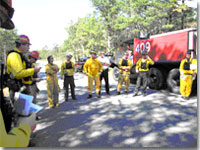 Natural communities within the Camp Edwards Training Site (CETS) are fire dependent systems shaped over thousands of years.
Natural communities within the Camp Edwards Training Site (CETS) are fire dependent systems shaped over thousands of years. With Euro-American influence, the natural fire regime has mostly been suppressed and replaced with infrequent human induced catastrophic fires. Further anthropogenic changes to the environment surrounding Camp Edwards has greatly accelerated in recent times with home building and population growth, creating a severe wildland urban interface. With this development it is imperative that the MAARNG and the surrounding communities address and plan for wildland fire.
It is the intent of the MAARNG and other stake holders that fire be reintroduced to this system using a landscape scale approach. It is critical to the success of this undertaking that wildland and prescribed fire planning is in place to ensure the most ecologically sound and safest approach to this endeavor.
The goal of fire management is to support the military mission of the Camp Edwards Training Site, to promote public safety and the protection of the surrounding community from wildland fire, while promoting the sustainable management of native biological systems by encouraging sound fire management planning, policy, and procedure and also to:
- water supply and wildlife habitat protection,
- the development and construction of public water supply systems, and
- the use and training of the military forces of the commonwealth; provided that, such military use and training is compatible with the natural resource purposes of water supply and wildlife habitat protection.
Fire History
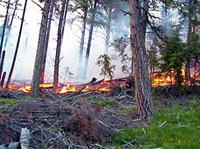 The forests of the Upper Cape Cod region have been impacted both by natural and human caused fires throughout the historical period. Although detailed information is lacking for prehistoric fires, we assume, given the pyrogenic vegetation encountered by the Pilgrim settlers of the area, that fires did impact the forests of Cape Cod. Sedimentary charcoal from Mary Dunn Pond, in nearby Barnstable, suggests that fire was common in prehistoric pitch pine oak forests (Ruffner and Patterson, in preparation). Human ignitions have accounted for the vast majority of all fires during the historical period. Only one lightning-caused fire was recorded in 1843. One early deed (1658) for Native fields in Mashpee suggested that "The fields over the pond have been cleared and improved by the Indians as long as the oldest can remember" (Mass Archives 33 - 245-247). If we infer that the Natives used fire to clear and maintain agricultural fields, this quote suggests long-term use of fire on the landscape (Delcourt 1987, Patterson and Sassaman 1988, Hammett 1992, Clark and Royall 1994).
The forests of the Upper Cape Cod region have been impacted both by natural and human caused fires throughout the historical period. Although detailed information is lacking for prehistoric fires, we assume, given the pyrogenic vegetation encountered by the Pilgrim settlers of the area, that fires did impact the forests of Cape Cod. Sedimentary charcoal from Mary Dunn Pond, in nearby Barnstable, suggests that fire was common in prehistoric pitch pine oak forests (Ruffner and Patterson, in preparation). Human ignitions have accounted for the vast majority of all fires during the historical period. Only one lightning-caused fire was recorded in 1843. One early deed (1658) for Native fields in Mashpee suggested that "The fields over the pond have been cleared and improved by the Indians as long as the oldest can remember" (Mass Archives 33 - 245-247). If we infer that the Natives used fire to clear and maintain agricultural fields, this quote suggests long-term use of fire on the landscape (Delcourt 1987, Patterson and Sassaman 1988, Hammett 1992, Clark and Royall 1994).
Despite efforts to reduce wildfire hazard, large catastrophic fires struck the region repeatedly. The first fire in Barnstable County to be recorded in Colonial records occurred in 1768 on the north side of Herring River (now Cape Cod Canal), apparently set by Elisha Bourne (Keene 1975). In 1772 a notable fire struck the "woodlot" and "sheep pasture" areas of Sandwich. While no estimate of the size was recorded, it must have impacted a large area given the large loss of an estimated 10,000 head of sheep (Freeman 1858).
Fires were recorded somewhat more frequently during the 19th century with major fires occurring every 21.8 ± 5.9 years (mean ± SE). These fires were large in extent, averaging 10,730 acres in size with the largest being 25,000 acres. All documented fires of the 1800s were apparently human-caused with one exception; the lightning ignition of 1843 which burned through cut-over lands of the Sandwich Glass Works (Yarmouth Register 1843). With expanding farming and industrial activities on the Cape, it is doubtful that these were the only fires that occurred on Cape Cod during this period. Those found in the historical record probably only represent the largest and most notable fires of the 19th century.
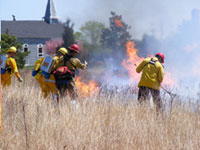 The first half of the 20th century (1900-1950) witnessed unprecedented growth on Cape Cod with the development of summer beach colonies and expanding military operations at the JBCC leading to a higher fire incidence. On average, large fires burned forests of the Upper Cape every 3.3 years during this period. Despite the fire prevention and control efforts of the Commonwealth, the average size of these fires was still high (7,271.9 ± 3,389 acres), although somewhat smaller than those of the 19th century. Investigations published after the fires fail to identify the cause of most, although it was speculated by the District Fire Warden that many fires were incendiary in nature (Crowell 1932). Others were certainly started by military activities, often beginning in the Impact Area after artillery training or, in the case of the disastrous 1946 fires, by German POW's burning slash piles.
The first half of the 20th century (1900-1950) witnessed unprecedented growth on Cape Cod with the development of summer beach colonies and expanding military operations at the JBCC leading to a higher fire incidence. On average, large fires burned forests of the Upper Cape every 3.3 years during this period. Despite the fire prevention and control efforts of the Commonwealth, the average size of these fires was still high (7,271.9 ± 3,389 acres), although somewhat smaller than those of the 19th century. Investigations published after the fires fail to identify the cause of most, although it was speculated by the District Fire Warden that many fires were incendiary in nature (Crowell 1932). Others were certainly started by military activities, often beginning in the Impact Area after artillery training or, in the case of the disastrous 1946 fires, by German POW's burning slash piles.
Fire frequency increased dramatically on the military reservation after 1950 with increased use of the training areas. Large fires (>1000 acres) occurred more frequently than in previous periods (one every 3.8 ± 1.6 years), but the average size of fires larger than 1000 acres decreased after 1950 to 746 ± 207 acres. All of these large fires were the result of artillery fire in the Impact Area. During this period, many smaller fires caused by small-arms fire, incendiary explosions, and even cooking fires occurred across the training areas. Better records exist for the period 1975-1997 and thus more complete statistics are available. On average, 23.5 ± 3.2 fires occurred annually with fires recorded in every month of the year. High fire occurrence years were 1980, 1990, 1991, and 1993. This may be a consequence of higher numbers of troops training during these years and/or years with unusual drought conditions. Palmer drought index records for Cape Cod over the past 100 years indicate that during 1980-1982, several months with PDSI at or near -3.0 were identified, which is indicative of severe drought. Nineteen eighty-nine to1990 and 1992-1993 had wet, warm winters, but very dry growing season months. Fire weather conditions appear to have been optimal for ignition and spread during the years 1980, 1990, 1991, and 1993. These years reflect wet summer and fall conditions followed by very dry springs. This scenario provides for ample growth and build-up of fuels during the previous growing season followed by dry spring conditions when fire danger is highest.
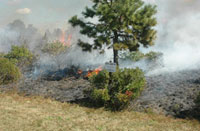 During this period (1975-1997), fire occurrence by month was fairly predictable with many fires occurring during March and April when the deciduous species have not yet leafed out. However, the higher occurrence of fires in May and June appears to correlate with the higher numbers of National Guard troops in annual training during these months (CPT Morin, Range Control Officer).
During this period (1975-1997), fire occurrence by month was fairly predictable with many fires occurring during March and April when the deciduous species have not yet leafed out. However, the higher occurrence of fires in May and June appears to correlate with the higher numbers of National Guard troops in annual training during these months (CPT Morin, Range Control Officer).
Since 1997, all artillery and mortar weapons fire has been banned at Camp Edwards; resulting in lessening the influence of human induced ignitions within the Impact Area. Also, as a result of the same weapons ban, artillery simulators (i.e., pyrotechnics) have not been used throughout the rest of the Camp Edwards training site, again lessening the influence of human induced ignitions (Mike Ciaranca, personal communication).
General Policy and Management Actions
General wildland fire policy for the JBCC is to control fires due to the potential for damage to resources, the protection of property, and to avoid potential liability from property loss and threats to human safety. However, an integral part of wildland fire management at Camp Edwards includes proactive steps at both the local and landscape scale. Many of the vegetation types at the JBCC are classified as fire associated early successional communities and result from past wildfires or other human caused disturbances. In fact, many of the largest fires occurring in Massachusetts, in the last 30 years, have originated within Camp Edwards. Some have threatened surrounding developments and communities, all of which are expanding rapidly along the installation boundary. Given this history, prudent fuel management strategies are warranted to reduce wildfire intensity in case of occurrence.
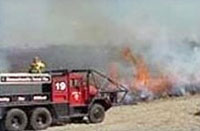 Scientists and land managers additionally recognize that these unique fire prone systems, sometimes referred to as pine barrens, serve as habitat to many rare plants and animals. These systems have quickly become fragmented as a result of land development. The JBCC is one of the few remaining pine barrens communities in the northeastern United States where land management through prescribed fire remains a viable option. Using fire as a tool has the advantage of replicating the natural role of fire in regenerating barrens vegetation and retarding succession. This is an ecosystem management approach suggested to aid in the maintenance of biodiversity and vital ecological processes to which endemic species have adapted to through time (Franklin 1993, Hunter 1999; Bergeron et al 2001). The Natural Resource Office, working in the MAARNG Environmental & Readiness Center, oversees and administers the conservation program that protects the endangered species and historical sites on the CETS. One of the primary wildfire protection priorities is installation natural and culturalresources, thus it is necessary to integrate fire and natural/cultural resource management planning with military preparedness and training.
Scientists and land managers additionally recognize that these unique fire prone systems, sometimes referred to as pine barrens, serve as habitat to many rare plants and animals. These systems have quickly become fragmented as a result of land development. The JBCC is one of the few remaining pine barrens communities in the northeastern United States where land management through prescribed fire remains a viable option. Using fire as a tool has the advantage of replicating the natural role of fire in regenerating barrens vegetation and retarding succession. This is an ecosystem management approach suggested to aid in the maintenance of biodiversity and vital ecological processes to which endemic species have adapted to through time (Franklin 1993, Hunter 1999; Bergeron et al 2001). The Natural Resource Office, working in the MAARNG Environmental & Readiness Center, oversees and administers the conservation program that protects the endangered species and historical sites on the CETS. One of the primary wildfire protection priorities is installation natural and culturalresources, thus it is necessary to integrate fire and natural/cultural resource management planning with military preparedness and training.
All fire planning efforts must consider what impacts fire pre-suppression and suppression activities will have on the natural/cultural resources they are designed to protect. Fire fighting strategies must minimize impacts to, natural and cultural resources, such as rare and endangered species habitat, watersheds, and historical and archaeological sites.
Wildland Fire Management Options
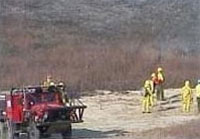 Fire management strategies specific to Camp Edwards at the JBCC include wildland fire suppression, wildland fire use, prescribed fire, non-fire fuel application, vegetation conversion, no action policy, and emergency rehabilitation and restoration. Descriptions and considerations of these potential management options follow:
Fire management strategies specific to Camp Edwards at the JBCC include wildland fire suppression, wildland fire use, prescribed fire, non-fire fuel application, vegetation conversion, no action policy, and emergency rehabilitation and restoration. Descriptions and considerations of these potential management options follow: Wildland Fire Suppression: Extinguishing or confining a fire: Complete fire suppression was a policy followed at the JBCC in the early 1980's with limited success. Dozens of ignitions annually produced wildfires that grew to several hundred acres in size before containment. Experience elsewhere on Cape Cod and Plymouth County suggests that the occurrence of catastrophic, large fires can be delayed but not eliminated through a policy of prevention, detection, and suppression. Larger fires may take place at longer intervals through complete suppression, but may be greater in intensity. Long intervals between major fires actually heighten danger to the public, as people forget that fires occur and do not control flammable accumulations of fuels around structures. The rapid growth of residential areas on the perimeter of a large area of highly flammable vegetation is a paramount concern to public officials and emergency preparedness organizations throughout the Upper Cape area. Fire must be suppressed in residential areas adjacent to Camp Edwards.However, large tracts of unbroken and highly flammable fuels within the reservation require active fuels management, if for no other reason than to protect private property adjacent to Camp Edwards. The ecological impacts of fire suppression are somewhat irrelevant if we assume that wildfires will eventually burn through the area. Wildfire occurrence has been the case for the better part of 200 years at what is now the Joint Base Cape Cod (JBCC) and the result has been the maintenance of fire adapted natural communities.
Wildland Fire Use: The application of the appropriate management response to unintentionally and naturally-ignited wildland fires to accomplish specific resource management objectives. Wildland fire use as
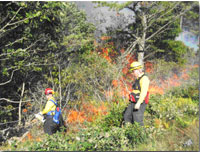 a management strategy is not currently utilized at the JBCC. Naturally occurring wildfires are rare; however, wildfire like scenarios can arise from fires caused by military activity. As the acceptance of fire management on the reservation expands, greater consideration will be given to the use of wildland fire and its potential in controlling other wildland fires. JBCC fire fighters and those of the surrounding communities must be informed and trained on how to use this technique while still meeting their mandate of protecting public interest.
a management strategy is not currently utilized at the JBCC. Naturally occurring wildfires are rare; however, wildfire like scenarios can arise from fires caused by military activity. As the acceptance of fire management on the reservation expands, greater consideration will be given to the use of wildland fire and its potential in controlling other wildland fires. JBCC fire fighters and those of the surrounding communities must be informed and trained on how to use this technique while still meeting their mandate of protecting public interest. Prescribed Fire: This option is the intentional application of fire to achieve ecosystem management objectives utilizing an approved natural resources fire management site specific burn plan. Present scientific thought suggests that basing land management actions upon structuring processes, such as fire, aids in maintaining naturally occurring community composition and structure (Franklin 1993; Hunter 1999; Bergeron 2001; Bergeron 2002). Prescribed fire is a land managementapproach that more closely replicates the natural disturbance regime of pine barrencommunities. The generation of smoke, which can affect areas adjacent to the JBCC, and the potential for escaped fires impacting areas outside intended management units, requires skillful planning and application.. Camp Edwards, and partner organizations have acquired much experience with applying prescribed fire to the landscape, and much has been learned about how to maximize success and minimize adverse effects. The prescribed fire program at Camp Edwards has gainedsupport of the National Guard Bureau, the National Park Service, the United States Fish and Wildlife Service, the MassachusettsDepartments of Environmental Protection, the Massachusetts Department of Conservation and Recreation, the Massachusetts Division of Fisheries, Massachusetts Wildlife's Natural Heritage and Endangered Species Program, and surrounding local fire departments. The program has also received support from non-governmental organizations such as The Nature Conservancy and the Massachusetts Audubon Society.
Non-Fire Fuel Application: Mechanical manipulation or removal of fuels to reduce the probability of ignition of fire (i.e. Mechanical treatments - lopping, chipping, harvesting, mowing, etc.).
Mechanical treatment has most often involved the use of machinery to cut, chop, and or grind vegetation.
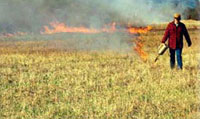 Where soils are not disturbed, native species usually re-sprout and produce, for a few years, young vigorousstands that are somewhat less flammable. Mechanical treatments compact fuel beds reducing the intensity of fires that might burn on treated areas. However, fine fuels are not removed, and the potential for fire burning through treated areas is not completely eliminated. Some floral components need mineral soil exposure through a process that does not till (i.e. disturb) the soil for germination and propagation.
Where soils are not disturbed, native species usually re-sprout and produce, for a few years, young vigorousstands that are somewhat less flammable. Mechanical treatments compact fuel beds reducing the intensity of fires that might burn on treated areas. However, fine fuels are not removed, and the potential for fire burning through treated areas is not completely eliminated. Some floral components need mineral soil exposure through a process that does not till (i.e. disturb) the soil for germination and propagation. At Camp Edwards, one constraint to mechanical treatment is unexploded ordinance, primarily within the Impact Area and associated ranges. Non-fire fuel applications such as mechanical treatments have potential for reducing fire hazard on portions of the JBCC, but initial treatments would likely proceed slowly and follow up would be required as vegetation re-establishes and new fuels accumulate. It is likely a combination of mechanical with prescribed fire would be used. This combination in general reduces fire behavior and may allow burning in ares that otherwise could not be treated with prescribed fire.
Vegetation Conversion: Reducing probability of wildfire through conversion to less flammable vegetation (i.e., natural succession). This is a fire management strategy attempted through the early decades of the twentieth century with little success. An active planting program at Myles Standish State Forest in Plymouth resulted in no more than 10% of the landscape being converted to less flammable white (Pinus strobus) and red pine (P. resinosa ). Attempts to plant deciduous species, especially poplar (Populus spp.), were less successful. A similar planting attempt occurred at the JBCC (former Shawme-Crowell State Forest Area) during the Depression of the 1930s. Wildfires destroyed many young plantations, which often could not compete with flammable native vegetation. Lack of suitability of many of the less flammable species to the dry, nutrient poor soils of the JBCC would require costly soil preparation and amendment. Insect and disease outbreaks in unhealthy stands have and would likely continue to cause failure of plantations. Conversion would be costly both ecologically and economically. Ecologically, many of the rarer plant, insect, and bird species that occupy barrens areas do not fair well in more densely forested landscapes, thus the value of the JBCC as rare species habitat would decline.
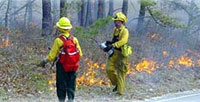 Emergency Rehabilitation and Restoration: A management response to the potential for resource harm from the management options discussed above; all post-fire stabilization and restoration activities fall within this umbrella. This action would facilitate or prevent resource harm immediately following wildfires by augmenting soils or doing planting to protect areas from resource damage such as erosion. This activity is not a true fire management option but a response to the effects of a wildfire or similar action that has the potential to destabilize natural resources (i.e., erosion).
Emergency Rehabilitation and Restoration: A management response to the potential for resource harm from the management options discussed above; all post-fire stabilization and restoration activities fall within this umbrella. This action would facilitate or prevent resource harm immediately following wildfires by augmenting soils or doing planting to protect areas from resource damage such as erosion. This activity is not a true fire management option but a response to the effects of a wildfire or similar action that has the potential to destabilize natural resources (i.e., erosion). No Action Policy: Reducing wildfire by taking no direct management action. This is a benign neglectconcept, where the hazard of fire may be reduced if management actions (i.e., disturbance) do not occur and pyrogenic vegetation is left to naturally succeed to less flammable vegetation types. Foster and Motzkin (1999) suggest that the climax plant community on Camp Edwards is an oak - pine forest with gray birch ( Betula populifolia ), American beech (Fagus grandifolia ), and bitternut hickory (Carya cordiformis ); which is far less pyrogenic. However, this type of action would not provide for the biodiversity goals stated within the INRMP and likely those of the resource agencies of the state of Massachusetts.
Burn plans and prescriptions will be prepared by a qualified fire planner using a systematic decision making process containing measurable objectives and all necessary environmental compliance documents and permits. Methodology (i.e., ignition tactics, holding, smoke mitigation, mop-up, etc.) and resource requirements will also be considered and laid out given site location and specific burn objectives. Prescriptions will address required (i.e., weather and fuel conditions that cannot be modified) and guidance (i.e., factors that can be modified through management activity) parameters in view of weather, fuel moisture, and fire behavior. Contingency actions to be taken in the event that the prescription is exceeded will also be included in the planning. Final review of all fire planning will be completed by the MAARNG Natural Resource Office and the delegated burn boss before any on-the-ground implementation occurs.
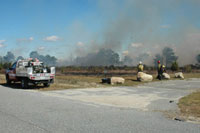 Training and Safety: Training is the key to safe and successful wildfire and prescribed fire incidents. With out training for planned and unplanned fire events, public and firefighter safety may be compromised. Safety is the first and highest priority and will never be compromised by other objectives. Safety is the responsibility of everyone assigned to a wildfire or prescribed fire incident. Safety is an attitude that must be promoted at all operational levels. Once personnel are committed to an incident, those resources become the highest value to be protected.
Training and Safety: Training is the key to safe and successful wildfire and prescribed fire incidents. With out training for planned and unplanned fire events, public and firefighter safety may be compromised. Safety is the first and highest priority and will never be compromised by other objectives. Safety is the responsibility of everyone assigned to a wildfire or prescribed fire incident. Safety is an attitude that must be promoted at all operational levels. Once personnel are committed to an incident, those resources become the highest value to be protected.
Fighting wildfires is inherently dangerous, and firefighters risk injury or even death in these operations. Nationally wildland firefighter fatalities occur nearly every year. In addition to the danger from the fire itself, the need to use cutting tools, mobile apparatus, heavy equipment, and aircraft add to the risk involved. If firefighters know how to recognize potentially hazardous situations and how to mitigate them, they can reduce or eliminate much of that risk.
Training will be established to provide standardization for directorates and organizations that are responsible for fire fighting, wildfire, and prescribed fire duties. Training and qualification requirements will be established for wildland fire fighting personnel including planning, prevention, suppression, and supervision duties. Any CETS organization or Directorate intending to provide personnel for wildfire incidents will be expected to meet the requirements described in this program.
The training program, qualification, and certification process are the foundations of a safe fire program. Only qualified personnel will be assigned fire fighting duties. All assigned wildland fire personnel, whether on wildfires or prescribed fires, must meet National Wildfire Coordinating Group (NWCG) training standards, as outlined in the PMS.
CETS firefighters or outside cooperating agencies shall meet the required wildland fire fighter training and physical fitness requirements outlined within each respective agency's established policies or training program. Training opportunities offered by the CETS will be shared with outside cooperative agencies for cross-leveling and sharing of training opportunities within the area, such as other states National Guard, state and local fire departments, and nongovernmental agencies.
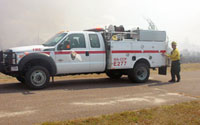 Partnering: The importance of interaction with partner organizations for both short and long-term programmatic success cannot be overstated. Current partners assisting in the Camp Edwards fire management activities include the National Park Service (NPS), Department of Environmental Protection (DEP), the Massachusetts Department of Conservation and Recreation (DCR), the Massachusetts Division of Fisheries and Wildlife (DFW), the University of Massachusetts at Amherst (UMASS), the Otis Air National Guard Base Fire Department, The Nature Conservancy (TNC), the Massachusetts Audubon Society, as well as other state, municipal, and non-governmental groups. Camp Edwards remains open to collaborating with other outside organizations that may have interest and/or expertise in fire management on the camp and elsewhere on the JBCC.
Partnering: The importance of interaction with partner organizations for both short and long-term programmatic success cannot be overstated. Current partners assisting in the Camp Edwards fire management activities include the National Park Service (NPS), Department of Environmental Protection (DEP), the Massachusetts Department of Conservation and Recreation (DCR), the Massachusetts Division of Fisheries and Wildlife (DFW), the University of Massachusetts at Amherst (UMASS), the Otis Air National Guard Base Fire Department, The Nature Conservancy (TNC), the Massachusetts Audubon Society, as well as other state, municipal, and non-governmental groups. Camp Edwards remains open to collaborating with other outside organizations that may have interest and/or expertise in fire management on the camp and elsewhere on the JBCC.
Cooperative agreements with various federal, state, and local agencies generally provide that resources of each agency are available to assist in initial attack fire suppression actions, aircraft and other resource use, and further fire management efforts. A Memorandum of Understanding, or the like, should exist between the JBCC and each outside organizations providing aid with fire management on the reservation for clarification of responsibilities by all parties involved.
Public Affairs and Community Involvement
The PAO and general public will be notified prior to prescribed fires. Other protocols also exist for public notification related to any unusual occurrence at the base, such as a wildfire or the effects of a wildfire that would have the potential to cause alarm. The three tiered system, is based upon the time interval prior to or after the unusual occurrence. Door-to-door mailings may also be sent out when conducting prescribed fire near private homes adjacent to base boundaries.
Monitoring and evaluation
Monitoring activities on Camp Edwards are built upon the Integrated Training Area Management Program (ITAM); the U.S. Army standard for sustaining the capability of installation lands to support military training while assuring the protection to cultural and natural resources, the compliance with statutory regulations, and the integration of environmental planning into operational protocol. The Range and Training Land Assessment (RTLA), formerly the Land Condition Trend Analysis Program (LCTA), is the ecological monitoring component of the ITAM, which serves to characterize and monitor installation natural resources in both time and space via a random
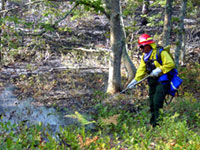 stratified permanent plot sampling system. Originally made up of 30 core permanent plots, the system has expanded to currently include a total of 246 plots to account for underrepresented community types and disturbed sites. Data obtained from RTLA surveys are integrated with information gathered from other corresponding components of the ITAM (for example, cultural resources surveys, wetlands surveys, endangered species surveys, water quality monitoring; see Ciaranca et al. 2001 for a complete description of the ITAM program), as well as satellite imagery and aerial photography to portray a total picture of the natural and cultural resources of the Camp Edwards training site. The RTLA plot surveys are conducted each year, from June to August or as otherwise determined.
stratified permanent plot sampling system. Originally made up of 30 core permanent plots, the system has expanded to currently include a total of 246 plots to account for underrepresented community types and disturbed sites. Data obtained from RTLA surveys are integrated with information gathered from other corresponding components of the ITAM (for example, cultural resources surveys, wetlands surveys, endangered species surveys, water quality monitoring; see Ciaranca et al. 2001 for a complete description of the ITAM program), as well as satellite imagery and aerial photography to portray a total picture of the natural and cultural resources of the Camp Edwards training site. The RTLA plot surveys are conducted each year, from June to August or as otherwise determined.
The intrinsic benefit derived from the RTLA monitoring program is that it provides a scientifically valid baseline, which addresses natural resource issues holistically in time and space (i.e., ecosystem management). This baseline grants the ability to focus the timing and scale of fire management activities based on threat to life and property, troop training, and land health. Successes and shortcomings of fire management activities (i.e., fire effects) are also quantitatively measurable with the RTLA system and allow for adaptive steps for future fire use. Further details of RTLA monitoring can be found in the US Army Construction Engineering Research Laboratories (1992) and U.S. Army Environmental Center (1997a).
Additional fire specific monitoring outside of the RTLA protocol is also conducted at Camp Edwards. Weather is monitored closely prior to a burn day to assess conditions in terms of safety and potential ecological benefit. During prescribed burns, fire behavior is recorded digitally and with film for a qualitative account during fire events. Weather is also closely monitored throughout burns to ensure activities remain within prescription and to ensure safety. Post-burn summaries are generated, which assess the influence of certain management activities such as fire and smoke behavior, weather, and first order fire effects (i.e., those effects that are concerned with the direct or immediate consequences of fire, such as biomass consumption, crown scorch, bole damage, and smoke production. Other supplementary monitoring protocols are also being assessed that would allow for improvement to documentation processes, better evaluation of success or failure of a prescribed burn, and better evaluation of potential of future efforts on Camp Edwards.
For citations see Camp Edwards Integrated Fire Management Plan.